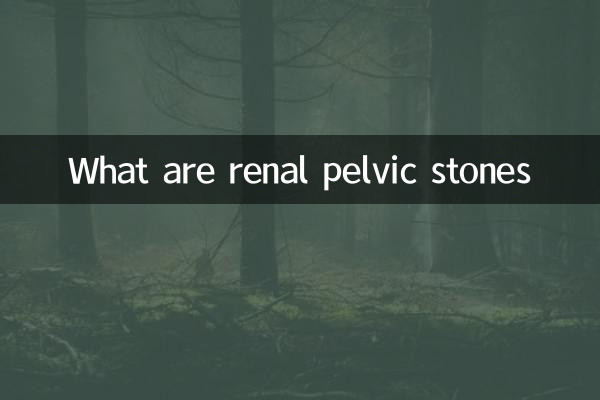What are renal pelvic stones
Pelvic stones are a common urinary system disease that refers to the formation of solid crystalline material in the renal pelvis of the kidneys. These stones usually form deposits of minerals and salts in the urine and can cause severe pain, urinary tract infections, and even kidney damage. In recent years, the incidence of renal pelvic stones has been on the rise, which is closely related to factors such as dietary structure and living habits. The following is a detailed analysis of renal pelvic stones.
1. Causes and types of renal pelvic stones

The formation of renal pelvis stones is related to many factors, including metabolic abnormalities, urinary tract obstruction, infection, etc. According to its chemical composition, it is mainly divided into the following categories:
| Stone type | Main ingredients | Proportion |
|---|---|---|
| calcium oxalate stones | Calcium oxalate | About 70%-80% |
| calcium phosphate stones | calcium phosphate | About 5%-10% |
| uric acid stones | uric acid | About 5%-10% |
| infectious stones | Magnesium ammonium phosphate | About 10%-15% |
2. Symptoms of renal pelvic stones
Symptoms of renal pelvic stones vary depending on the size and location of the stone. Common manifestations include:
| symptom | describe |
|---|---|
| renal colic | Sudden severe pain, often in the waist or flank |
| hematuria | Hematuria visible to the naked eye or under a microscope |
| Frequency and urgency of urination | Stones irritate the urinary tract and cause abnormal urination |
| Nausea and vomiting | Pain-induced autonomic nervous system response |
3. Diagnosis and treatment
The diagnosis of renal pelvic stones mainly relies on imaging examinations and laboratory tests:
| Check method | Features |
|---|---|
| Ultrasound examination | Non-invasive, convenient, suitable for pregnant women and children |
| CT scan | Diagnostic accuracy is as high as over 95% |
| Urine routine | Detect hematuria, infection, etc. |
The treatment plan needs to be formulated based on the size of the stone and the patient’s condition:
| Treatment | Applicable situations |
|---|---|
| Medication to remove stones | Stones <6mm in diameter |
| extracorporeal shock wave lithotripsy | Stones with a diameter of 6-20mm |
| Ureteroscopy | Middle and lower ureteral stones |
| percutaneous nephrolithotomy | Large or complex kidney stones |
4. Preventive measures
The key to preventing renal pelvic stones is to adjust your lifestyle:
| Precautions | Specific methods |
|---|---|
| Drink more water | Daily urine output is maintained at 2-2.5L |
| diet modification | Limit high-oxalate foods (e.g., spinach, nuts) |
| Control sodium | Daily salt intake should not exceed 6g |
| moderate exercise | Promote the passage of small stones |
5. Recent hot topics
According to the hot spot data of the entire network in the past 10 days, the discussion on renal pelvic stones mainly focuses on the following aspects:
| topic | heat index |
|---|---|
| Progress in minimally invasive surgical treatment | ★★★★☆ |
| Artificial Intelligence Assisted Diagnosis | ★★★☆☆ |
| Warning for high incidence of stones in summer | ★★★★★ |
| Controversy over traditional Chinese medicine stone removal therapy | ★★★☆☆ |
High temperatures in summer lead to increased water loss from the human body and concentrated urine, causing a significant increase in the incidence of kidney stones. Experts suggest that special attention should be paid to hydration in summer to avoid prolonged exposure to high temperatures.
Conclusion
Renal pelvic stones are a common urinary system disease, and early detection and standardized treatment are crucial. Through reasonable preventive measures and a healthy lifestyle, the risk of disease can be effectively reduced. If relevant symptoms occur, you should seek medical treatment promptly to avoid delaying treatment and causing damage to kidney function.

check the details

check the details